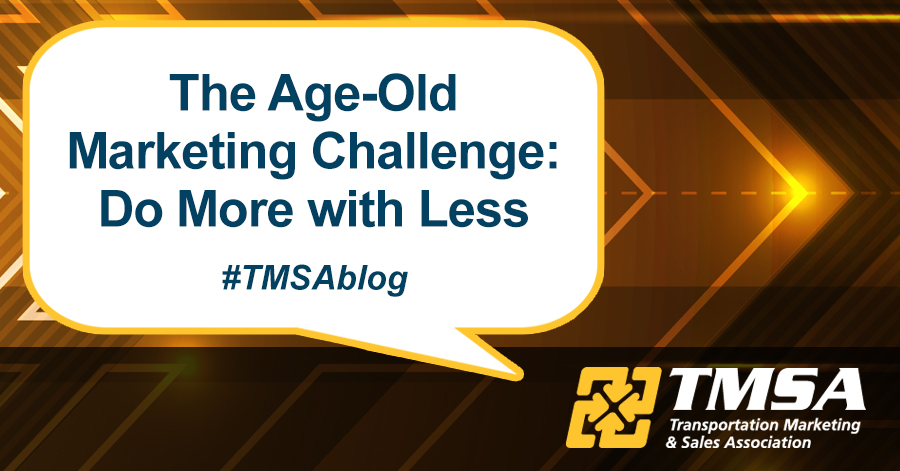
Written By: TMSA Staff | Jan 4, 2018 12:00:00 AM
Now that you have a new marketing budget, in many cases the challenge remains: You may not have more budget to accomplish what you did last year, yet expectations for more tangible business results have increased.
In fact, according to the 2017 TMSA Sales & Marketing Study, less than 50% saw increases in their marketing budgets last year. (Download an Executive Summary). It’ll be interesting to see if there are any emerging trends or shifts when it comes to budgets in in 2018.
That said, how can you squeeze the most out of your limited budget resources? Here are 7 practical ideas:
1. Fully leverage your advertising media buy. Advertising on its own is expensive (to produce and purchase ad space). But there are creative ways to amplify the power of your media buy. For example, you can order an ample supply of reprints and distribute them to customers and prospects every chance you get. When you send literature in response to an inquiry, include a copy of the ad in the package.
Also, distribute ads internally to other departments-production, sales, customer service and R&D--to keep them up to date on your latest marketing and promotional efforts. Make sure your salespeople receive an extra supply of reprints and are encouraged to include a reprint when they communicate with or visit customers.
Another suggestion: Convert the ad into a product data sheet by adding technical specifications and additional product information to the back of the ad reprint. This eliminates the expense of creating a new layout from scratch - and it makes good marketing sense, because the reader gets double exposure to your advertising message.
Lastly, ad reprints can be used as inexpensive direct mail pieces. You can mail the reprints along with a reply card and a sales letter. Unlike the ad, which is "cast in concrete," the letter is easily and inexpensively tailored to specific markets and customer groups. Use your advertising repeatedly. You’ll leverage your advertising investment - and increase frequency in the process.
2. If something works, stick with it. Too many marketers scrap their used promotions and create new ones because they're bored with their current campaign. Remember: While you grow tired of a campaign, your market likely has not. Don’t create new creative concepts or promotions if your existing ones are still working accurately and effectively. Run your campaigns for as long as your customers react to them. And if a concept still has selling power but the promotion contains dated information, simply update the existing content--don't throw it out and start from scratch.
3. Adopt "modular" product literature. One common advertising problem is how to promote a single product to many small, diverse markets. Each market has different needs and will purchase for different reasons. But on your budget, you can't afford to create a separate brochure for each of these tiny market segments. A modular literature systems means creating a basic brochure layout that has sections capable of being tailored to meet specific market needs. After all, most sections of the brochure (ranging from technical specifications, product or service information, company background) will be the same regardless of the audience. Only a few sections, such as benefits of the product to the user and typical applications, need to be tailored to specific readers. In a modular layout, standard sections remain the same but new copy can be incorporated for each market-specific section of the brochure. Using this approach, you can create different market-specific pieces of literature on the same product using the same basic layout and art files. Significant savings in time and money will result.
4. Explore less expensive alternatives for lead generation. Whether it be banner advertising, organic search and PR, many smaller transportation and logistics companies judge marketing effectiveness solely by the number of leads generated. They’re not concerned with building image or recognition, but they simply count inquiries.
5. Post all your press releases in a media or press section of your website. Optimize your press releases with key word phrases to draw more organic search traffic.
6. Do it yourself. Outsourcing marketing activities continues to be a common trend for those in transportation and logistics. In fact, in the 2017 TMSA Sales & Marketing Metrics Study, more and more companies are outsourcing non-essential functions that may require more specialized capabilities. According to the study, these functions are being outsourced: Website design (60%), Creative/Design (49%), Media Relations (27%), and Marketing Research (25%).
7. Repurpose content whenever possible! Get maximum mileage out of existing content (text and images). Photography, illustrations, layouts and even copy created for one campaign oftentimes can be lifted and repurposed in other marketing channels to significantly reduce creative costs.
Interested in learning more about how to maximize your marketing budget?
Join TMSA and visit the Members Only Website for valuable resources or whitepapers on this topic.
Check out the TMSA Blog for more related articles!
Spark new ideas: View TMSA Best Practices in Marketing & Sales Library.
Tags: Strategy